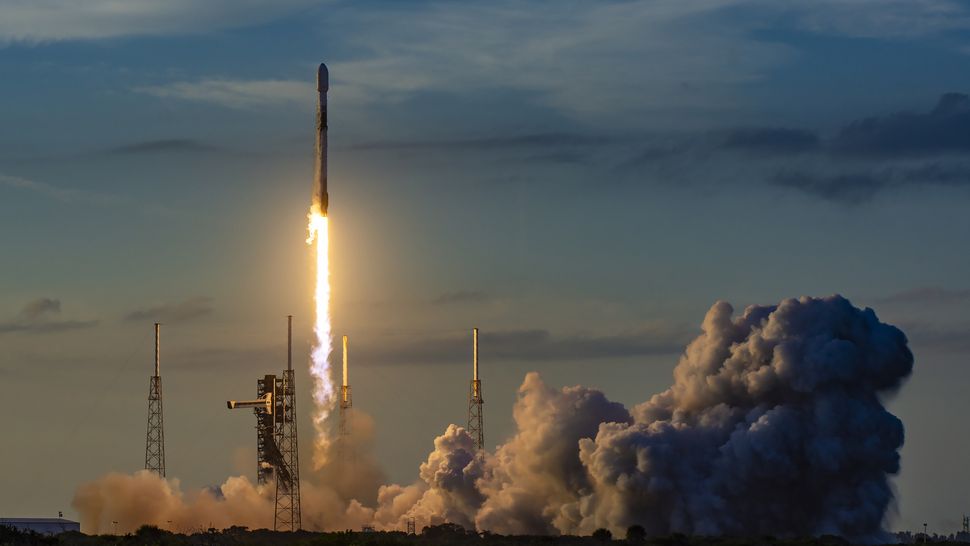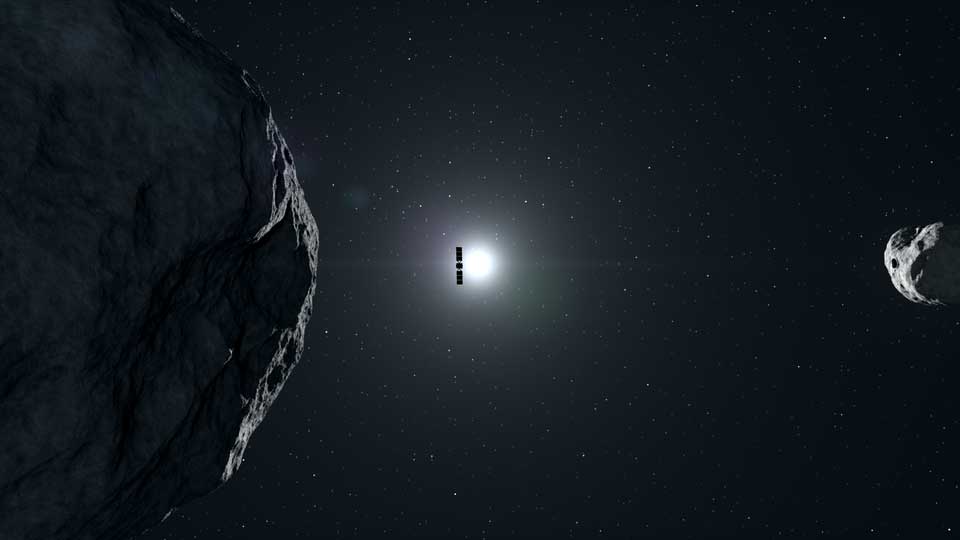Dimorphos is a moon of the near-Earth asteroid Didymos. This binary asteroid system was previously visited by NASA’s DART spacecraft, which deliberately collided with Dimorphos in 2022 and changed its orbit around Didymos as a demonstration of a planetary defense technique designed to change the trajectory of a potentially hazardous asteroid.
SpaceX launched the European Hera spacecraft to the asteroid Dimorphos on October 7 to assess the impact. The European Space Agency’s Hera mission will visit Dimorphos, the asteroid that NASA’s Double Asteroid Redirection Test (DART) spacecraft knocked off course in September 2022. Hera will assess the impact and study both the surface and the interior of the asteroid in more detail.
The main Hera spacecraft and its two CubeSat partners, named Milani and Juventas, launched on a SpaceX Falcon 9 rocket on Monday (October 7) at 10:52 a.m. ET (14:52 GMT) from the Cape Canaveral Space Station in Florida.

If all goes well, Hera will arrive at Dimorphos in late 2026. The spacecraft will assess the size and depth of the crater created by DART, as well as the effectiveness of the impact.
Hera will also deploy two CubeSats to study the interior structure, surface minerals, and gravity of Dimorphos. This data will help researchers better understand how the impact affected the asteroid, and in turn, provide valuable information for future asteroid deflection missions.
ESA will continue to study the binary asteroids with the upcoming Hera mission, scheduled to launch later this year. Hera will be a follow-up to NASA’s DART mission, which encountered Dimorphos, a moon orbiting the asteroid Didymos, in 2022 as an asteroid deflection test to conduct a post-impact survey of Dimorphos. It will be the first probe to encounter a binary asteroid system.
Another spacecraft, Gaia, helped astronomers see the shadow cast by Didymos as it passed in front of more distant stars in 2022, an observation method known as stellar occultation. The feasibility of this method has been dramatically improved by Gaia’s asteroid orbits and ultra-precise star maps in recent years, proving the mission’s enormous value to solar system exploration.

Artistic representation of Hera gliding past Didymus to Dimorphos
By studying data collected by NASA’s Double Asteroid Redirection Test (DART) mission, which sent a spacecraft to deliberately collide with the asteroid Dimorphos in 2022, the mission’s science team has gained new insights into the origins of the target binary asteroid system and why the DART spacecraft was so effective in shifting Dimorphos’ orbit.
In five recently published papers in the journal Nature Communications, the team investigated the geology of a binary asteroid system comprising the moon Dimorphos and the parent asteroid Didymos to characterize its origin and evolution and constrain its physical properties.
“These results give us new insights into how asteroids can change over time,” said Thomas Statler, lead scientist for small solar system bodies at NASA Headquarters in Washington. “This is important not only for understanding near-Earth objects, which are a focus of planetary defense, but also for our ability to read the history of our solar system from these remnants of planet formation. This is just part of the wealth of new knowledge we have gained from DART.”
Olivier Barnouin and Ronald-Louis Ballouz of the Johns Hopkins Applied Physics Laboratory (APL) in Laurel, Maryland, led the work, which analyzed the geology of both asteroids and inferred their surface materials and interior properties. Using images from DART and its companion LICIACube cubesat, provided by the Italian Space Agency (ASI), the team observed the topography of the smaller asteroid Dimorphos, which included boulders of varying sizes. By comparison, the larger asteroid Didymos was smoother at lower altitudes, though rockier at higher ones, with more craters than Dimorphos. The authors concluded that Dimorphos likely separated from Didymos in a large mass ejection.
There are natural processes that can speed up the rotation of small asteroids, and there is growing evidence that these processes may be responsible for changing the shape of these bodies or even causing material to be ejected from their surfaces.

Various geological features observed on Didymos have helped researchers piece together the origin story of Didymos. The asteroid’s triangular ridge (first panel from left), the so-called smooth region, and its likely older, rougher “highland” region (second panel from left) can be explained by a combination of elevation-controlled tilting processes (third panel from left). The fourth panel shows the effects of the rotational perturbation that Didymos likely underwent to form Dimorphos. Johns Hopkins APL/Olivier Barnouin/NASA
The analysis showed that both Didymos and Dimorphos have weak surface features, leading the team to conclude that Didymos has a surface age 40 to 130 times older than Dimorphos, with the former estimated at 12.5 million years old and the latter at less than 300,000 years old. Dimorphos’s weak surface strength likely contributed to DART’s significant impact on its orbit.
“The images and data that DART collected in the Didymos system provided a unique opportunity to study the geology of a binary near-Earth asteroid system,” Barnouin said. “From these images alone, we were able to infer a wealth of information about the geophysical properties of both Didymos and Dimorphos and advance our understanding of the formation of these two asteroids. We also have a better understanding of why DART was so effective in moving Dimorphos.”
Maurizio Paiola of the National Institute for Astrophysics (INAF) in Rome and co-authors conducted a study comparing the shapes and sizes of different boulders and their distribution patterns on the surfaces of the two asteroids. They determined that Dimorphos’s physical characteristics indicate that it formed in stages, likely from material inherited from its parent asteroid, Didyma. This finding supports the prevailing theory that some binary asteroid systems arise from the ejected remains of a larger primary asteroid accumulating in the asteroid’s new satellite.
Alice Lucchetti, also of INAF, and her colleagues found that thermal fatigue — the gradual weakening and cracking of material when exposed to heat — can rapidly erode boulders on Dimorphos’ surface, creating surface lines and changing the physical characteristics of this type of asteroid faster than previously thought. The DART mission was likely the first observation of such a phenomenon on this type of asteroid.
Led by researcher Naomi Murdoch of ISAE-SUPAERO in Toulouse, France, and colleagues, the paper, led by students Jeanne Bigot and Pauline Lombardo, found that Didymos’s load-bearing capacity — the ability of the surface to withstand applied loads — is at least 1,000 times lower than that of dry sand on Earth or lunar soil. This is considered an important parameter for understanding and predicting surface response, including for asteroid displacement.
Colas Robin, also of ISAE-SUPAERO, and co-authors analyzed surface boulders on Dimorphos, comparing them to boulders on other asteroid piles, including Itokawa, Ryugu, and Bennu. The researchers found that the boulders have similar characteristics, suggesting that all of these types of asteroids formed and evolved in similar ways. The team also noted that the elongated shape of the boulders around the DART impact site suggests that they likely formed through impact processing.
These latest results provide a more robust picture of the origin of the Didymos system and add to our understanding of how such planetary bodies formed. As the European Space Agency’s Hera mission prepares to revisit the DART impact site in 2026 to further analyse the effects of the first-ever planetary defence test, this study provides a series of tests of what Hera will find and contributes to current and future exploration missions while strengthening planetary defence capabilities.
The Johns Hopkins University Applied Mathematics Laboratory managed the DART mission for NASA’s Planetary Defense Coordination Office, a project of the agency’s Planetary Mission Program Office. NASA provided mission support from several centers, including the Jet Propulsion Laboratory in Southern California, NASA’s Goddard Space Flight Center in Greenbelt, Maryland, Johnson Space Center in Houston, Glenn Research Center in Cleveland, and Langley Research Center in Hampton, Virginia.




